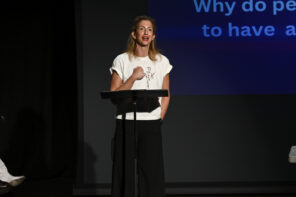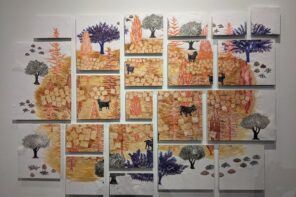MAKER The Movie
MAKER (Documentary, USA, Taiwan, 66 minutes), dir. Mu-Ming Tsai
Orange County Museum of Art, 850 San Clemente Dr,. Newport Beach, CA 92660
February 27, 2015
Maker builds a case for an enduring post-consumerism society
When it comes right down to it, we’re all a little bit materialistic. If any of you have played that game about which six items would you take to a stranded island, there’s a good chance a majority of you would include your phone, something shiny, Netflix, etc. (this writer included). You see, the problem is that we are so busy worrying about the stuff we can’t live without, we take for granted that which we need in order to live, namely sustenance. Of course, all of this is readily available for most of us—but what about for those not so fortunate? A loaded question, but one whose answer has burst forth in the form of Mu-Ming Tsai’s 2014 award-winning documentary, Maker; part posthumous report, part love letter to the physical manifestations of man’s insatiable thirst to reach for the stars. Tsai’s film rings out from its celluloid in ballads of hammer-against-nail, soldering-iron-against-motherboard circuitry, in a cacophonous ‘we shall overcome!’
When we’ve already reached the stars, made possible exploration of the ocean’s depths, and are well on our way to conquering time and usurping ‘age’ from its throne, you have to wonder, “Haven’t we already done it?”.
Except, we haven’t even scratched the surface. Not really.
Maker wastes no time waking us up to our present condition, to the idea that as we’ve let ‘stuff’ accumulate in our lives (think “ready-mades” and industrial, mass-produced items), a key element has been lost; a sense of value and meaning in objects. If we assume the idea that that which we surround ourselves with—our collections, decorations, trinkets, and furniture—is what determines our identity and self-worth, then it wouldn’t be farfetched to guess that Tsai is saying we’ve somehow managed to lose a sense of value and meaning with regards to ourselves in the process. He uses his film to make a case for the ongoing Maker Movement, which reimagines the “tinkerer in his [or her] workshop”, showing audience members that not only can they take control of their lives with something as simple as a hammer and nail, but do so in a way that, as the film puts it, gives the individual a chance to look at an object and say, “I made this” and the sense of completion that comes with that.
Maker gets its title not only from its namesake movement, but from the various men and women culled from a very wide spectrum of age and background, and interviewed within the film. From the young to the old, able-bodied and not so much, Tsai manages to display a seemingly long lost creativity, patience, and boldness in the shrugging simplicity of an adolescent learning to solder computer chips, or a graffiti artist suffering from ALS who is able to continue his work via specialized eyeglasses “made” to track retina movement. What the film is quick to point out, however, is that any one of the Makers whose work we see could just as interchangeably be an audience—sometimes it’s as simple as opening a Kickstarter account; underwater sea exploration vessels, satellites, smart watches—all possible because of online crowdfunding and its inherent democratization of taking ideas and turning them into physical being.
As with most of the Art, Architecture, & Design films presented by the Cinema Orange film society, Maker ignites a sense of wonderment and awe in its audiences. It’s worth noting that serial documentary viewers would be right to point out an ironically diluted soundtrack (marimba, anyone?), interchangeable, crisp-white cinematography, and a lack of any sort of narrative… but the strength of Tsai’s film is in what it isn’t: a film that leaves you wanting an intangible ‘more’ out of life, the kind that often imbues documentaries whose content stretches such a grand chasm of meaning and placated time, viewers oftentimes get lost in the daydream shuffle. On the other end of the spectrum is Maker’s underappreciated frankness, combining with the always congenial notion of materialistic consumerism abandonment, in favor of its director’s focused pursuance of a creativity ingrained into each of us, whether that creativity is driven by numbers or the way the sunlight shines through a piece of glass that has been broken. As the film is quick to point out (quite literally, at a brisk 66-minute runtime), there is no limit to the ‘how’, ‘what’ and ‘why’s’ of innovation, perhaps … the only question left is – ‘when.’
From the producers of the internationally acclaimed “Design & Thinking,” Maker looks into a new wave of Do-It-Yourself and Do-It-Together culture fueled by passion and powered by the advent of new technologies. The film explores the ideas, tools, and personalities that are driving the Maker Movement – and returns with a timely snapshot of one of the transforming influences of the current age. [OCMA]
The Orange County Museum of Art is located in Newport Beach, near Fashion Island, at 850 San Clemente Dr., Newport Beach, CA 92660. Hours for the museum are: MON-TUES, closed; WED-SUN, 11:00am-5:00pm; THUR, 11:00am-8:00pm.
Now in its eleventh season celebrating the cinematic works and of emerging and established independent filmmakers, OCMA and the Newport Beach Film Festival present the 2015 Cinema Orange film series. Films will explore art, design and cultural icons. Interactive question and answer sessions with filmmakers will follow select screenings. Cinema Orange is organized by Leslie Feibleman, director of special programs and community cinema, Newport Beach Film Festival.





